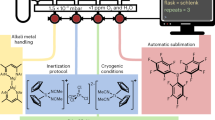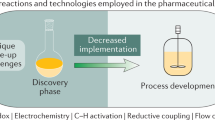Abstract
Conventional thermochemical syntheses by continuous heating under near-equilibrium conditions face critical challenges in improving the synthesis rate, selectivity, catalyst stability and energy efficiency, owing to the lack of temporal control over the reaction temperature and time, and thus the reaction pathways1,2,3. As an alternative, we present a non-equilibrium, continuous synthesis technique that uses pulsed heating and quenching (for example, 0.02 s on, 1.08 s off) using a programmable electric current to rapidly switch the reaction between high (for example, up to 2,400 K) and low temperatures. The rapid quenching ensures high selectivity and good catalyst stability, as well as lowers the average temperature to reduce the energy cost. Using CH4 pyrolysis as a model reaction, our programmable heating and quenching technique leads to high selectivity to value-added C2 products (>75% versus <35% by the conventional non-catalytic method and versus <60% by most conventional methods using optimized catalysts). Our technique can be extended to a range of thermochemical reactions, such as NH3 synthesis, for which we achieve a stable and high synthesis rate of about 6,000 μmol gFe−1 h−1 at ambient pressure for >100 h using a non-optimized catalyst. This study establishes a new model towards highly efficient non-equilibrium thermochemical synthesis.
This is a preview of subscription content, access via your institution
Access options
Access Nature and 54 other Nature Portfolio journals
Get Nature+, our best-value online-access subscription
$29.99 / 30 days
cancel any time
Subscribe to this journal
Receive 51 print issues and online access
$199.00 per year
only $3.90 per issue
Buy this article
- Purchase on Springer Link
- Instant access to full article PDF
Prices may be subject to local taxes which are calculated during checkout




Similar content being viewed by others
Data availability
The data that support the findings of this study are available within this article and its Supplementary Information. Further data are available from the corresponding authors on reasonable request. Source data are provided with this paper.
Code availability
The code used for active learning has been deposited in the Code Ocean repository (ref. 41).
References
Bailey, J. E. Periodic operation of chemical reactors: a review. Chem. Eng. Commun. 1, 111–124 (1973).
Wolff, J., Papathanasiou, A. G., Kevrekidis, I. G., Rotermund, H. H. & Ertl, G. Spatiotemporal addressing of surface activity. Science 294, 134–137 (2001).
Kevrekidis, I. G., Schmidt, L. D. & Aris, R. Some common features of periodically forced reacting systems. Chem. Eng. Sci. 41, 1263–1276 (1986).
Chorkendorff, I. & Niemantsverdriet, J. W. Concepts of Modern Catalysis and Kinetics 3rd edn (Wiley, 2017).
Marin, G. B., Yablonsky, G. S. & Constales, D. Kinetics of Chemical Reactions: Decoding Complexity 2nd edn (Wiley, 2019).
Papathanasiou, A. G., Wolff, J., Kevrekidis, I. G., Rotermund, H. H. & Ertl, G. Some twists and turns in the path of improving surface activity. Chem. Phys. Lett. 358, 407–412 (2002).
Guo, X. et al. Direct, nonoxidative conversion of methane to ethylene, aromatics, and hydrogen. Science 344, 616–619 (2014).
Calkins, W. H. & Bonifaz, C. Coal flash pyrolysis: 5. Pyrolysis in an atmosphere of methane. Fuel 63, 1716–1719 (1984).
Hao, J. et al. Enhanced methane conversion to olefins and aromatics by H-donor molecules under nonoxidative condition. ACS Catal. 9, 9045–9050 (2019).
Sakbodin, M., Wu, Y., Oh, S. C., Wachsman, E. D. & Liu, D. Hydrogen-permeable tubular membrane reactor: promoting conversion and product selectivity for non-oxidative activation of methane over an Fe@SiO2 catalyst. Angew. Chem. Int. Ed. 55, 16149–16152 (2016).
Šot, P. et al. Non-oxidative methane coupling over silica versus silica-supported iron(II) single sites. Chem. Eur. J. 26, 8012–8016 (2020).
Wu, Y. et al. Overgrowth of lamellar silicalite-1 on MFI and BEA zeolites and its consequences on non-oxidative methane aromatization reaction. Microporous Mesoporous Mater. 263, 1–10 (2018).
Liu, L. et al. Methane dehydroaromatization on Mo/HMCM-22 catalysts: Effect of SiO2/Al2O3 ratio of HMCM-22 zeolite supports. Catal. Lett. 108, 25–30 (2006).
Zhang, Y. et al. Promotional effects of In on non-oxidative methane transformation over Mo-ZSM-5. Catal. Lett. 146, 1903–1909 (2016).
Aboul-Gheit, A. K., Awadallah, A. E., Aboul-Enein, A. A. & Mahmoud, A.-L. H. Molybdenum substitution by copper or zinc in H-ZSM-5 zeolite for catalyzing the direct conversion of natural gas to petrochemicals under non-oxidative conditions. Fuel 90, 3040–3046 (2011).
Bajec, D., Kostyniuk, A., Pohar, A. & Likozar, B. Micro-kinetics of non-oxidative methane coupling to ethylene over Pt/CeO2 catalyst. Chem. Eng. J. 396, 125182 (2020).
Xie, P. et al. Nanoceria-supported single-atom platinum catalysts for direct methane conversion. ACS Catal. 8, 4044–4048 (2018).
Xiao, Y. & Varma, A. Highly selective nonoxidative coupling of methane over Pt-Bi bimetallic catalysts. ACS Catal. 8, 2735–2740 (2018).
Butland, A. T. D. & Maddison, R. J. The specific heat of graphite: an evaluation of measurements. J. Nucl. Mater. 49, 45–56 (1973).
Bao, W. et al. Flexible, high temperature, planar lighting with large scale printable nanocarbon paper. Adv. Mater. 28, 4684–4691 (2016).
Van Geem, K. M., Galvita, V. V. & Marin, G. B. Making chemicals with electricity. Science 364, 734–735 (2019).
Wismann, S. T. et al. Electrified methane reforming: a compact approach to greener industrial hydrogen production. Science 364, 756–759 (2019).
Bai, Z., Chen, H., Li, B. & Li, W. Catalytic decomposition of methane over activated carbon. J. Anal. Appl. Pyrolysis 73, 335–341 (2005).
Gao, Z., Kobayashi, M., Wang, H., Onoe, K. & Yamaguchi, T. Methane conversion in thermal diffusion column reactor with carbon rod as pyrogen. Fuel Process. Technol. 88, 996–1001 (2007).
Shields, B. J. et al. Bayesian reaction optimization as a tool for chemical synthesis. Nature 590, 89–96 (2021).
Wang, Y., Chen, T.-Y. & Vlachos, D. NEXTorch: a design and Bayesian optimization toolkit for chemical sciences and engineering. J. Chem. Inf. Model. 61, 5312–5319 (2021).
Frenklach, M. Reaction mechanism of soot formation in flames. Phys. Chem. Chem. Phys. 4, 2028–2037 (2002).
Yablonsky, G. S., Constales, D. & Marin, G. B. Equilibrium relationships for non-equilibrium chemical dependencies. Chem. Eng. Sci. 66, 111–114 (2011).
Silva, G. D. Mystery of 1-vinylpropargyl formation from acetylene addition to the propargyl radical: an open-and-shut case. J. Phys. Chem. A 121, 2086–2095 (2017).
Mansurov, Z. A. Soot formation in combustion processes. Combust. Explos. Shock Waves 41, 727–744 (2005).
Saadatjou, N., Jafari, A. & Sahebdelfar, S. Ruthenium nanocatalysts for ammonia synthesis: a review. Chem. Eng. Commun. 202, 420–448 (2015).
Qin, R. et al. Alkali ions secure hydrides for catalytic hydrogenation. Nat. Catal. 3, 703–709 (2020).
Dahl, S., Sehested, J., Jacobsen, C. J. H., Törnqvist, E. & Chorkendorff, I. Surface science based microkinetic analysis of ammonia synthesis over ruthenium catalysts. J. Catal. 192, 391–399 (2000).
Bowker, M., Parker, I. B. & Waugh, K. C. Extrapolation of the kinetics of model ammonia synthesis catalysts to industrially relevant temperatures and pressures. Appl. Catal. 14, 101–118 (1985).
Wu, L., Hu, S., Yu, W., Shen, S. & Li, T. Stabilizing mechanism of single-atom catalysts on a defective carbon surface. NPJ Comput. Mater. 6, 1–8 (2020).
Özçelik, V. O., Gurel, H. H. & Ciraci, S. Self-healing of vacancy defects in single-layer graphene and silicene. Phys. Rev. B 88, 045440 (2013).
Ye, T.-N. et al. Vacancy-enabled N2 activation for ammonia synthesis on an Ni-loaded catalyst. Nature 583, 391–395 (2020).
Gong, Y. et al. Ternary intermetallic LaCoSi as a catalyst for N2 activation. Nat. Catal. 1, 178–185 (2018).
Kitano, M. et al. Ammonia synthesis using a stable electride as an electron donor and reversible hydrogen store. Nat. Chem. 4, 934–940 (2012).
Shi, M.-M. et al. Au sub-nanoclusters on TiO2 toward highly efficient and selective electrocatalyst for N2 conversion to NH3 at ambient conditions. Adv. Mater. 29, 1606550 (2017).
Dong, Q. et al. Active learning for programmable heating and quenching. Code Ocean https://doi.org/10.24433/CO.1790371.v1 (2021).
Acknowledgements
We acknowledge the support from the University of Maryland A. James Clark School of Engineering. We acknowledge the Maryland NanoCenter, the Surface Analysis Center and the AIM Lab. We thank M. R. Zachariah and D. J. Kline from the University of California, Riverside for their help on the temperature measurements. We thank E. Schulman from the University of Maryland, College Park for her help on the energy cost calculations. D.L. acknowledges the support from the Department of Energy, Office of Fossil Energy (DE-FE0031877). D.G.V. acknowledges the support from the Department of Energy, Office of Energy Efficiency and Renewable Energy and Advanced Manufacturing Office (DE-EE0007888-9.5). The Delaware Energy Institute acknowledges the support and partnership of the State of Delaware in furthering the essential scientific research being conducted through the RAPID projects. Y.J. acknowledges the support from the National Science Foundation (NSF EFRI DCheM-2029425).
Author information
Authors and Affiliations
Contributions
L.H., Q.D. and Y.Y. came up with the design concept. Q.D. and S.C. designed the reactor and collected the data for CH4 pyrolysis. Q.D., Y.Y. and J.G. collected the data for NH3 synthesis. K.A., H.E.T. and D.G.V. carried out the simulation for CH4 pyrolysis and the energy cost calculation. S.S. and Y.W. conducted the active learning. Q.D. and X.W. performed the temperature measurements. Y.P., C.Z. and B.Y. carried out the modelling for the temperature profile of the gas molecules. J.G. collected the digital images. Q.D. and Y.Y. conducted the spectroscopic and microscopic analysis. K.A., D.G.V., H.Z. and Y.J. carried out the simulation for NH3 synthesis. I.G.K. helped analyse the overall results. L.H., Q.D., Y.Y. and A.H.B. collectively wrote the paper, together with input from all authors. L.H., D.L. and D.G.V. supervised the project. All authors discussed the results and contributed to the final manuscript.
Corresponding authors
Ethics declarations
Competing interests
L.H., Y.Y., Q.D. and D.L. report a patent application of ‘High-temperature shock heating for thermochemical reactions’ filed on 12 March 2021, US application no. PCT/US2021/022204.
Peer review
Peer review information
Nature thanks the anonymous reviewers for their contribution to the peer review of this work.
Additional information
Publisher’s note Springer Nature remains neutral with regard to jurisdictional claims in published maps and institutional affiliations.
Supplementary information
Supplementary Information
This file contains Supplementary Methods; Supplementary Tables 1–3; Supplementary Discussions 1–15 and Supplementary References.
Rights and permissions
About this article
Cite this article
Dong, Q., Yao, Y., Cheng, S. et al. Programmable heating and quenching for efficient thermochemical synthesis. Nature 605, 470–476 (2022). https://doi.org/10.1038/s41586-022-04568-6
Received:
Accepted:
Published:
Issue Date:
DOI: https://doi.org/10.1038/s41586-022-04568-6
This article is cited by
-
Continuous and low-carbon production of biomass flash graphene
Nature Communications (2024)
-
Sub-second ultrafast yet programmable wet-chemical synthesis
Nature Communications (2023)
-
Plastic polymers split into reusable monomers using an electrical heating method
Nature (2023)
-
Ratcheting synthesis
Nature Reviews Chemistry (2023)
-
Depolymerization of plastics by means of electrified spatiotemporal heating
Nature (2023)
Comments
By submitting a comment you agree to abide by our Terms and Community Guidelines. If you find something abusive or that does not comply with our terms or guidelines please flag it as inappropriate.



